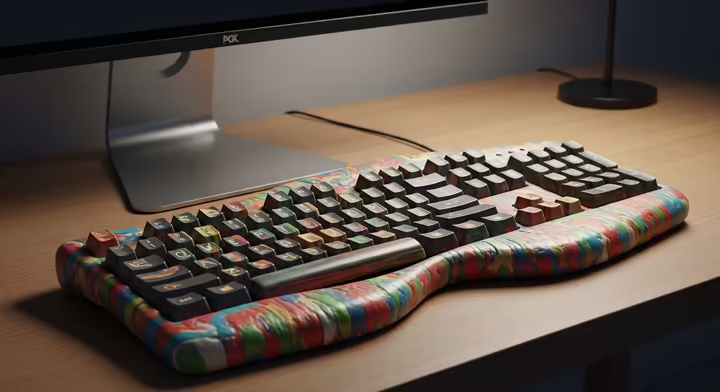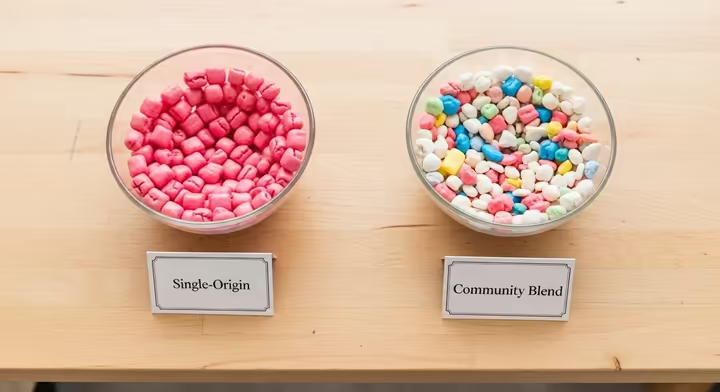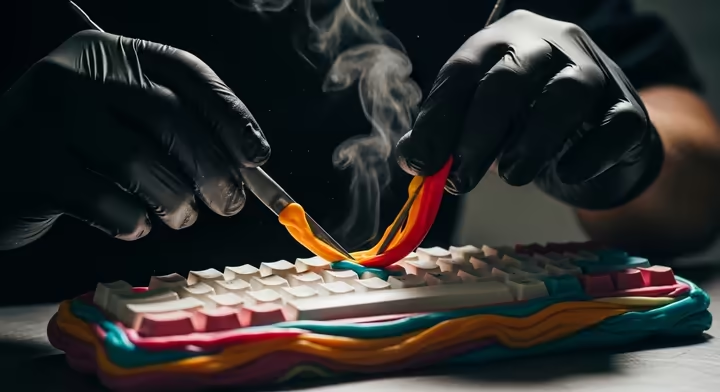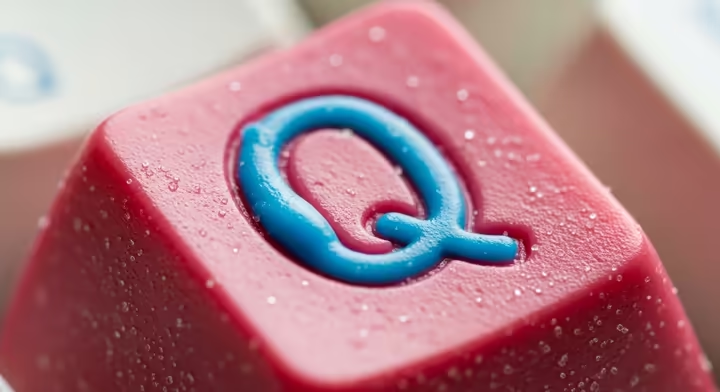How to Build a Keyboard Out of Chewed Gum
Ever wondered what happens to your chewing gum after you're done with it? Most people just chuck it. But what if you could turn that sticky wad into... a computer keyboard? This is a (mostly serious) look at how to build the Masticated Alphanumeric Interface, or MAI for short.

The Main Ingredient: Old Gum
Used chewing gum is a surprisingly useful biopolymer composite, perfect for making weird custom stuff. The leftover gum base, a mix of resins, waxes, and elastomers, is hydrophobic (it repels water), which is key for the whole process.
Sourcing Your Materials
First, you need your raw materials. You can go "single-origin" (gum from one person) or "community blend" (scraped from... wherever). A single-origin source lets you analyze how the donor's diet affects the gum's final properties, while a community blend gives you a more varied, complex material.

Chewing is actually the first step in manufacturing the material. The process gets rid of a lot of mass, up to 75% for sugary gums, as sweeteners and flavors dissolve in saliva. This purifies the gum, leaving behind the useful hydrophobic polymer base.
Picking Your Gum
Different gum brands have different properties after chewing, like different types of wood. Scientists measure this with things called storage (G′) and loss (G′′) moduli, which basically tell you how well the gum stores and releases energy, how springy vs. gooey it is. For example, bubble gum's tougher base might make a stronger keyboard frame, while a sugar-free gum could create a more stable (but brittle) keycap.
Chewing gum also has a very low critical strain, meaning it's sensitive to even small movements. This makes it great for creating unique tactile feedback. The table below shows how a few common brands stack up.
| Gum Brand | Initial Mass (g) | Mass Loss (%) | Storage Modulus (G′) (kPa) | Loss Modulus (G′′) (kPa) | Color Purity (L∗a∗b∗) |
|---|---|---|---|---|---|
| Trident | 1.95 | 68.3 | 25.4 | 12.1 | 55.2, 4.1, -1.9 |
| Wrigley's Spearmint | 2.15 | 72.9 | 19.8 | 9.7 | 59.7, -10.3, 11.5 |
| Dubble Bubble | 6.35 | 66.8 | 31.6 | 18.5 | 64.1, 41.5, 23.8 |
| Orbit | 2.05 | 60.1 | 28.9 | 15.6 | 58.9, 0.2, 0.8 |
Curing and Aging
After chewing, the gum needs to be carefully dried out to turn it from a pliable wad into a solid. This happens as water evaporates and the gum base goes through a "glass transition" around 37°C. The surrounding humidity is critical, too much humidity, and it stays tacky forever, and too little, and it gets brittle and might crack.
The keyboard won't rot, but it will age, developing a unique "patina" over time. This is a feature, not a bug. Gum is sticky because its hydrophobic polymers attract oils, so the keys will naturally collect oils from your fingers, creating a personal finish that tells the story of your typing. Dust, oils, and UV light will all change the surface, giving it character.
Building the Keyboard
Now for the keyboard body, or chassis. You've got two main options. The "laminated aggregate" technique is like making plywood, pressing individual pieces of gum together, while the more ambitious "monolithic molded" method involves sculpting the whole thing from one big blob of warm gum. The final shape can be made ergonomic, with tenting or tilting, to make typing more comfortable.

The Keys and Switches
The keys are the most important part. Instead of a normal mechanical spring, this switch uses the slow rebound of the semi-cured gum itself. You won't get a sharp "click," but a satisfying "squish" followed by a slow return, providing a unique kind of haptic feedback. The flavor of the gum might even affect how it feels...
Making It Look Good
You don't just print letters on the keys, that would be boring. Instead, you can use fancy craft techniques. The "intaglio" method involves carving letters into the keys, while "marquetry" uses different colored gum as an inlay. Using luxury techniques on what is literally garbage is what makes the whole idea so interesting. The final texture can be a "glossy, saliva-sheen" or a drier "matte, desiccated" finish.

Making It Work (The Tricky Part)
Okay, here's the biggest problem: gum doesn't conduct electricity. You could mix in conductive stuff like graphite powder while chewing, but that might ruin the gum's texture. This is a huge engineering hurdle.
A more sci-fi solution is "targeted polymerization." This (completely fictional) process would use a special energy frequency to create tiny conductive pathways inside the gum. This means you wouldn't just use any old gum, you'd need to buy special, pre-engineered "conductive gum," turning the project from a DIY hobby into a boutique manufacturing operation.
The Smell-o-Vision Interface
The MAI also has a unique "olfactory interface," it uses the leftover flavor for notifications. We get too many pop-ups and pings, a smell-based system is a way to get information without more screen clutter. For example, a whiff of wintergreen could signal a new email, while a burst of cinnamon could mean a critical system error. The smell would need to fade so the signal is effective but not overwhelming.
| Scent Profile | System Notification Trigger | Required Signal Intensity | Scent Decay Rate |
|---|---|---|---|
| Wintergreen | New Email | Low | Fast |
| Cinnamon | Critical System Error | High | Medium |
| Fruit Medley | Low Battery | Medium | Medium |
| Peppermint | System Idle | Low | Slow |
Your Keyboard's Microbiome
Your keyboard is going to get covered in bacteria. Instead of fighting it, this design embraces it as a "symbiotic microbial ecosystem." The unique bacteria that grows on it is a feature, not a bug, and could be managed with things like a "probiotic sealant" to keep things stable.
Common Problems (And Worries)
People who (hypothetically) own one of these keyboards have some unique problems. Forget about firmware updates, you're basically a gum farmer now.
- "How do I prevent my cat from trying to eat the spacebar?"
- "My WASD keys have lost their flavor and feel less responsive. Is it time for a re-seasoning?"
- "What is the best way to clean dust and hair out of the chassis without compromising its structural integrity?"
- "My keyboard melted slightly after I left it in my car. Is there a way to re-sculpt the F-keys?"
- "Is it possible to mix different brands of gum for a custom tactile feel, or will that cause material rejection?"
- "I'm trying to source single-origin spearmint gum for my build, but the donor keeps eating sugary snacks. How much will this affect the material's long-term durability?"
So, What's the Point?
So, is a keyboard made of chewed gum a good idea? Probably not. But it's a fun way to think about what "materials" can be, taking something worthless and temporary and making it into something custom and personal. The MAI is a proof-of-concept for a design philosophy that embraces weird materials, imperfections, and the fact that things change over time. It opens the door to a future of strange, personalized, bio-based gadgets.
Works cited
- Unconventional Computing, https://quantumcomputinginc.com/learn/lessons/unconventional-computing
- Unconventional computing - Wikipedia, https://en.wikipedia.org/wiki/Unconventional_computing
- Chewing gum - Wikipedia, https://en.wikipedia.org/wiki/Chewing_gum
- The Secret Science of Gum - American Chemical Society, https://www.acs.org/education/whatischemistry/adventures-in-chemistry/secret-science-stuff/gum.html
- Gum Mass Lab Experiment And Report | by Ruhee - Medium, https://ruhee-h.medium.com/gum-mass-lab-experiment-and-report-85865b25c7f2
- (PDF) A critical gel fluid with high extensibility: The rheology of ..., https://www.researchgate.net/publication/262182753_A_critical_gel_fluid_with_high_extensibility_The_rheology_of_chewing_gum
- US20140154353A1 - Nonlinear rheology of chewing gum and gum base - Google Patents, https://patents.google.com/patent/US20140154353A1/en
- Why is there generally no expiration date for chewing gums? - ICGA, https://www.gumassociation.org/index.cfm/facts-figures/frequently-asked-questions/why-is-there-generally-no-expiration-date-for-chewing-gums/
- What is Patina? | A guide to art terminology - Avant Arte, https://avantarte.com/glossary/patina
- What is patina? Everything you need to know about this vintage, aged look, according to designers and antiques experts - Homes and Gardens, https://www.homesandgardens.com/interior-design/what-is-patina
- Material Degradation, https://materialpathways.dk/material_degradation/
- Understanding Materials Degradation - Number Analytics, https://www.numberanalytics.com/blog/ultimate-guide-materials-degradation-informatics
- Non-Newtonian fluid - Wikipedia, https://en.wikipedia.org/wiki/Non-Newtonian_fluid
- Oobleck and Non-Newtonian Fluids: Crash Course Kids #46.1 - YouTube, https://www.youtube.com/watch?v=Fnd-2jetT1w
- Ergonomic keyboard - Wikipedia, https://en.wikipedia.org/wiki/Ergonomic_keyboard
- How Ergonomic Keyboards Work: Benefits & Features - E3 Consulting, https://www.ergonomicconsultants.com/blog/ergonomic-workspace/how-ergonomic-keyboards-work/
- The World of Tactile Switches: An In-Depth Look - Snaptron, https://www.snaptron.com/2025/06/the-world-of-tactile-switches-an-in-depth-look/
- Why Piezoelectric Elements Are Ideal for Haptic Feedback in Electronics | Same Sky, https://www.sameskydevices.com/blog/why-piezoelectric-elements-are-ideal-for-haptic-feedback-in-electronics
- Conductive Carbon Fiber Polymer Composite - NASA Technology Transfer Program, https://technology.nasa.gov/patent/LAR-TOPS-370
- RESEARCH OF A POLYMER BASE FOR CREATING AN ELECTRICALLY CONDUCTIVE GRAPHITE PASTE FOR MEDICAL PURPOSES | Request PDF - ResearchGate, https://www.researchgate.net/publication/357411497_RESEARCH_OF_A_POLYMER_BASE_FOR_CREATING_AN_ELECTRICALLY_CONDUCTIVE_GRAPHITE_PASTE_FOR_MEDICAL_PURPOSES
- Electrically conductive polymers and composites for biomedical ..., https://pubs.rsc.org/en/content/articlehtml/2015/ra/c5ra01851j
- Thermal Conductive Polymer Composites: Recent Progress and Applications - MDPI, https://www.mdpi.com/1420-3049/29/15/3572
- Olfactory Interaction Design-The Future Laboratory, Tsinghua ..., https://thfl.tsinghua.edu.cn/en/kxyj/Organization/Natural_Human_Machine_Interaction_and_User_Experie/yj/Ongoing/Olfactory_Interaction_Design.htm
- The Olfactory Medium. Smell in Human-Computer Interaction - STI Studies, https://sti-studies.com/wp-content/uploads/2019/11/7.1-the-olfactory.pdf
- Smart Scent Technology | Sense Company, https://sense-company.com/en-nl/smart-scent-technology
- Smart Home – Digital Scent Transformation for Fragrance Brands, Wellness, and IoT Providers - Inhalio, https://inhalio.com/markets/connected-home-digital-scent-diffuser/
- Microbiome Core | University of Michigan Medical School, https://medresearch.umich.edu/labs-departments/labs/microbiome-core
- Tools for Analysis of the Microbiome - PMC, https://pmc.ncbi.nlm.nih.gov/articles/PMC7598837/